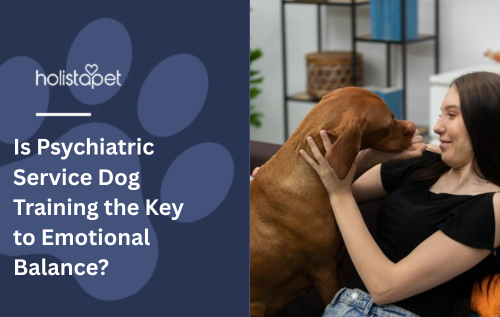If you've ever wondered how a loyal canine companion could offer more than just love—maybe even life-changing support—then you're in the right place. Psychiatric service dog training is gaining recognition for its powerful role in helping individuals with mental health conditions lead more grounded, independent lives.
In this post, we’ll explore what psychiatric service dog training involves, who it benefits, and how it differs from other types of service animal training.
 What Is Psychiatric Service Dog Training?
What Is Psychiatric Service Dog Training?
Psychiatric service dog training focuses on teaching dogs specific tasks to support individuals dealing with mental health challenges such as PTSD, depression, anxiety, or bipolar disorder. These dogs are not just pets—they are highly trained animals that help manage daily life in meaningful ways.
Common Tasks They Learn:
-
Grounding techniques during panic attacks
-
Waking someone from nightmares
-
Interrupting harmful behaviors
-
Reminding their handler to take medication
-
Guiding their handler to safety during disassociation episodes
Unlike emotional support animals, psychiatric service dogs are legally recognized under the Americans with Disabilities Act (ADA) and can accompany their handlers in public places.
Who Needs a Psychiatric Service Dog?
People managing conditions like:
-
Post-Traumatic Stress Disorder (PTSD)
-
Major Depressive Disorder
-
Generalized Anxiety Disorder
-
Schizophrenia or Dissociative Disorders
...often find these trained companions life-enhancing and sometimes even lifesaving.
 Frequently Asked Questions
Frequently Asked Questions
1. How is psychiatric service dog training different from regular obedience training?
Obedience training teaches basic commands like "sit" or "stay." Psychiatric service dog training involves task-specific commands to mitigate symptoms of mental health conditions, making it more specialized and intensive.
2. Can I train my own psychiatric service dog?
Yes, in many countries (including the U.S.), you’re allowed to train your own dog. However, working with a professional trainer experienced in psychiatric needs is highly recommended.
3. What breeds are best for psychiatric service dog training?
Labrador Retrievers, Golden Retrievers, and Poodles are popular choices due to their intelligence, temperament, and trainability. But any breed with the right disposition and temperament may be a good candidate.
4. How long does training take?
Full training can take anywhere from 6 months to 2 years, depending on the dog's age, previous training, and the handler's specific needs.
5. Is certification or registration required?
No official certification is required by law in many areas. However, a well-documented training record and the ability to perform tasks reliably in public are essential.
Helpful Notes
-
Early socialization is crucial for future psychiatric service dogs. Exposure to various environments helps them stay calm under pressure.
-
Always verify a trainer’s experience with psychiatric-specific service dogs, not just general obedience.
-
Reputable trainers will often create custom training plans based on the handler's specific mental health diagnosis and goals.
-
Keep a training log—it helps in case of legal concerns or when access issues arise in public spaces.
Final Thoughts
Psychiatric service dog training isn’t just about obedience—it’s about empowering individuals to face everyday life with a sense of safety, routine, and reassurance. If you or a loved one is navigating mental health challenges, exploring this path could be a powerful next step.
Take the time to assess your needs, learn about training options, and find the right support to walk with you—paw by paw—toward a more balanced life.


 CBD Oil for Dogs - Fast Acting
CBD Oil for Dogs - Fast Acting
 Chicken Flavored CBD Oil For Dogs - Easy Dose
Chicken Flavored CBD Oil For Dogs - Easy Dose
 Salmon Flavored CBD Oil For Dogs - Highly Rated
Salmon Flavored CBD Oil For Dogs - Highly Rated
 CBG Oil for Dogs and Cats - Loved by Thousands
CBG Oil for Dogs and Cats - Loved by Thousands





Leave a comment
This site is protected by hCaptcha and the hCaptcha Privacy Policy and Terms of Service apply.